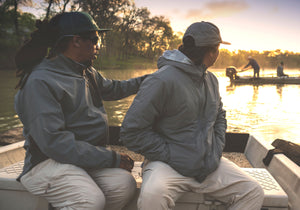Not all anglers choose to wear fly fishing waders when they’re out on the water, but they are a great way to stay dry. After all, wading isn’t always required. To avoid spooking the fish, it’s usually recommended that you only wade when necessary and it’s safe to do so.
But for others, getting into the water is part of the joy of fly fishing. If this is you — or you just want the option — you’ll need a sturdy pair of waders.
If you haven’t had waders before (or you haven’t bought a new pair for several years) it can be difficult to know where to start. Find out if you need fly fishing waders and what to look for in this guide.
What do fly fishing waders do?
Waders keep you comfortable, safe, and dry when you’re in the water for sustained amounts of time. They can also help protect you from hypothermia (extreme cold symptoms) and stop you getting cut on jagged rocks beneath the water.
Waders aren’t just good for safety. They’re also highly practical. With pockets, belts, and built-in handwarmers, you can ensure you have everything you need without having to head back to the bank every few minutes.
What to consider in your waders
There are three key factors to consider when choosing your fly fishing waders:
- Size
- Material
- Type of foot.
Let’s take a look at how each of these helps you choose the right waders.
Finding the right size waders
Because waders are designed for safety, they need to fit properly. This helps prevent premature wear and pressure on the seams. They’re an all-in-one garment, so it’s important to take multiple body measurements before you buy — especially if you’re shopping online.
All good fly fishing wader stockists and manufacturers will have a size guide on their website, so you can take your own measurements and choose the waders that will best fit you. At Orvis, the measurements men will need are:
- Chest size (inches)
- Inseam length (inches)
- Shoe size
We offer men’s waders in various leg lengths, and sizes ranging from S to XXL, so you can find well-fitting waders regardless of your proportions.
Women looking for waders will need a few additional measurements. Take these measurements before you buy:
- Clothes size
- Bust
- Waist
- Hip
- Inseam
- Shoe size (US sizing)
Orvis women’s waders are available in sizes ranging from XS to XXL, and in petite, regular, or tall lengths. Learn more about finding your wader fit.
Choosing the right wader material
Traditionally, waders were made from rubber. But this heavy, non-breathable material is rarely used these days. Instead, most waders are made from a combination of nylon and neoprene.
Nylon is a lightweight, highly breathable material that keeps you cool and dry. Orvis nylon waders like the Clearwater wader have a 30K waterproof rating — the highest possible water resistance rating. Nylon waders are a fantastic choice, especially if you prefer to fish in warmer temperatures. Our ultralight waders are lightweight, compact, and ideal for travelling.
Cordura can be another perfect choicel for waders.This is heavier and tougher than nylon, so it gives great resistance against tears and punctures. Orvis Cordura waders have been developed over 3 years, ensuring they’re optimised for cooler temperatures and climates. They’re ideal when warmth is a priority. Check out the Pro Wader to learn more.
Neoprene is also commonly used as a wader material. However, while it’s inherently waterproof, neoprene tends to be less breathable than other materials. At Orvis, we use neoprene for our built-in booties for maximum comfort within your wading boots.
Bootfoot vs stockingfoot waders
Waders are available with two foot options: bootfoot or stockingfoot. Bootfoot waders come with attached wading boots, so you won’t need separate footwear in addition to your waders. Stockingfoot waders come with attached booties, which are waterproof and are designed to fit comfortably inside your wading boots.
Stockingfoot waders are the most popular choice. While they tend to be more expensive than bootfoot waders, they’re more versatile and more comfortable. You can choose the right boots for your trip (whether it’s freshwater or saltwater fly fishing) and pair them with your waders.
Bootfoot waders can be a cheaper, more convenient option. Many people choose them as they’re easier to get on and off, and are usually more affordable than buying separate boots and waders. But while they’re equally effective at keeping your feet dry, it can be more difficult to find bootfoot waders that are comfortable for both your body and your feet. You might also need to compromise on whether your boots have a rubber or felt sole, which can make a difference to your safety and comfort when wading.
How to choose your fly fishing waders
Now you know more about the features of different waders, you can choose the ones that suit you best. Do this by assessing your individual needs, such as your budget and which weather and environment you’ll be fishing in.
Take a look at the full range of Orvis fly fishing waders and find your ideal match.

